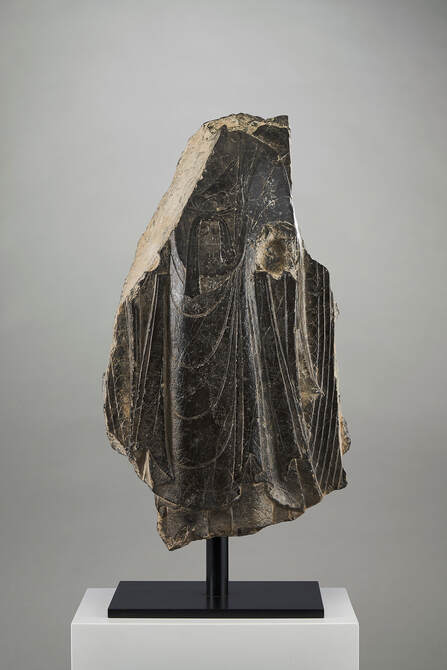0696-21
Fragment from a Stele of Shakyamuni Buddha
China, Honan Province, Eastern Wei dynasty (534 - 549CE), first half 6th century
Grey limestone
70 cm (27 1/2 in.)
A fragmentary grey limestone figure of Buddha, lacking his left hand and broken from the neck to the right hand, shown standing with the robes falling in flat formal folds stopping short at the foot to reveal an undergarment and the outline of the lower leg. The garment is tied across the chest with a flat knot. There are some remnants of a mandorla to the left of the figure and a stylised flowerhead behind his left shoulder. The flat reverse with incised rows of seated Buddhas divided by vertical rectangles.
Honan province, first half of 6th century, probably Eastern Wei (534-549).
The dark grey limestone and the fact that the Eastern Wei had its main centre in Honan would indicate an attribution to this province.
Two dated steles representing the Sakyamuni Buddha, one in the Museum Reitberg, illustrated in Chinese Sculptures in the von der Heydt Collection by Osvald Siren, no. 22, dated 536 and another in the Cleveland Museum of Art, illustrated by Hai-Wai Yi-Chen Chinese Art in Overseas Collections, Buddhist Sculpture II, no. 34, dated 537 exhibit the softer more curved treatment of the robes distinctive of Eastern Wei as opposed to the more sharp, harder style of Northern Wei. These also show the distinct knotting of the garment across the chest falling to the waist.
Another fragment that appears to come from the same stele, from the Ching-ya T’ang collection, was exhibited The Art of Contemplation - Religious Sculpture from Private Collections National Palace Museum, Taiwan, 1997, no. 13, page 80.
Published:
Nicholas Grindley, June 1998 / 4
Fragment from a Stele of Shakyamuni Buddha
China, Honan Province, Eastern Wei dynasty (534 - 549CE), first half 6th century
Grey limestone
70 cm (27 1/2 in.)
A fragmentary grey limestone figure of Buddha, lacking his left hand and broken from the neck to the right hand, shown standing with the robes falling in flat formal folds stopping short at the foot to reveal an undergarment and the outline of the lower leg. The garment is tied across the chest with a flat knot. There are some remnants of a mandorla to the left of the figure and a stylised flowerhead behind his left shoulder. The flat reverse with incised rows of seated Buddhas divided by vertical rectangles.
Honan province, first half of 6th century, probably Eastern Wei (534-549).
The dark grey limestone and the fact that the Eastern Wei had its main centre in Honan would indicate an attribution to this province.
Two dated steles representing the Sakyamuni Buddha, one in the Museum Reitberg, illustrated in Chinese Sculptures in the von der Heydt Collection by Osvald Siren, no. 22, dated 536 and another in the Cleveland Museum of Art, illustrated by Hai-Wai Yi-Chen Chinese Art in Overseas Collections, Buddhist Sculpture II, no. 34, dated 537 exhibit the softer more curved treatment of the robes distinctive of Eastern Wei as opposed to the more sharp, harder style of Northern Wei. These also show the distinct knotting of the garment across the chest falling to the waist.
Another fragment that appears to come from the same stele, from the Ching-ya T’ang collection, was exhibited The Art of Contemplation - Religious Sculpture from Private Collections National Palace Museum, Taiwan, 1997, no. 13, page 80.
Published:
Nicholas Grindley, June 1998 / 4
